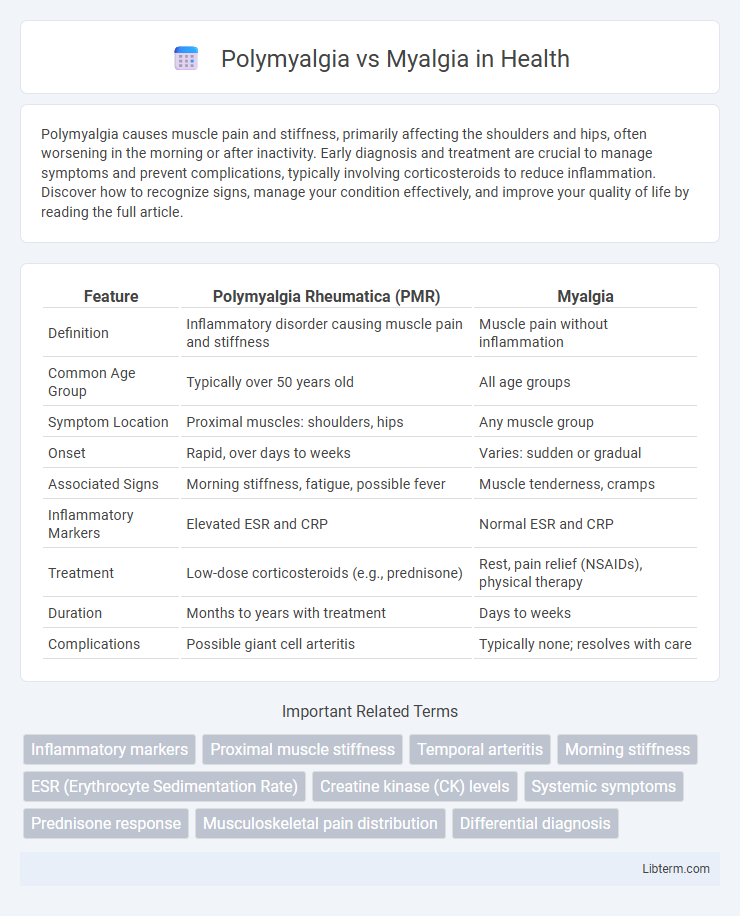Polymyalgia causes muscle pain and stiffness, primarily affecting the shoulders and hips, often worsening in the morning or after inactivity. Early diagnosis and treatment are crucial to manage symptoms and prevent complications, typically involving corticosteroids to reduce inflammation. Discover how to recognize signs, manage your condition effectively, and improve your quality of life by reading the full article.
Table of Comparison
| Feature | Polymyalgia Rheumatica (PMR) | Myalgia |
|---|---|---|
| Definition | Inflammatory disorder causing muscle pain and stiffness | Muscle pain without inflammation |
| Common Age Group | Typically over 50 years old | All age groups |
| Symptom Location | Proximal muscles: shoulders, hips | Any muscle group |
| Onset | Rapid, over days to weeks | Varies: sudden or gradual |
| Associated Signs | Morning stiffness, fatigue, possible fever | Muscle tenderness, cramps |
| Inflammatory Markers | Elevated ESR and CRP | Normal ESR and CRP |
| Treatment | Low-dose corticosteroids (e.g., prednisone) | Rest, pain relief (NSAIDs), physical therapy |
| Duration | Months to years with treatment | Days to weeks |
| Complications | Possible giant cell arteritis | Typically none; resolves with care |
Introduction to Polymyalgia and Myalgia
Polymyalgia rheumatica is an inflammatory disorder characterized by severe muscle pain and stiffness, primarily affecting the shoulders and hips, often accompanied by systemic symptoms such as fatigue and fever. Myalgia refers to general muscle pain that can result from various causes, including injury, infection, or overuse, without the systemic inflammation seen in polymyalgia rheumatica. Differentiating between polymyalgia and myalgia is crucial for accurate diagnosis and appropriate treatment, as polymyalgia rheumatica typically requires corticosteroid therapy to reduce inflammation.
Defining Polymyalgia: Key Characteristics
Polymyalgia rheumatica is an inflammatory disorder characterized by muscle pain and stiffness, primarily affecting the shoulders and hips, often accompanied by morning stiffness lasting more than 30 minutes. Unlike general myalgia, which refers broadly to muscle pain caused by factors such as injury, overuse, or infection, polymyalgia presents systemic symptoms including elevated inflammatory markers like ESR and CRP. Accurate diagnosis relies on clinical presentation, laboratory findings, and response to low-dose corticosteroids, distinguishing it from conditions with similar musculoskeletal complaints.
Understanding Myalgia: Common Features
Myalgia refers to generalized muscle pain caused by various factors, including overuse, injury, or viral infections, typically presenting with localized muscle tenderness and stiffness. Polymyalgia, or polymyalgia rheumatica, is an inflammatory disorder characterized by widespread muscle pain and stiffness, primarily affecting the shoulders and hips, and often accompanied by systemic symptoms such as fatigue and elevated inflammatory markers like ESR and CRP. Differentiating myalgia from polymyalgia is crucial for accurate diagnosis and treatment, as polymyalgia requires anti-inflammatory therapy while myalgia treatment targets the underlying cause of muscle pain.
Causes of Polymyalgia
Polymyalgia rheumatica is caused by inflammation in the large joints and muscles, typically triggered by an autoimmune response or genetic predisposition involving HLA-DR4 alleles. Unlike myalgia, which results from muscle strain, injury, or infections, polymyalgia often occurs in individuals over 50 and is associated with elevated inflammatory markers like ESR and CRP. The exact cause remains unclear, but environmental factors such as infections may also contribute to the onset of polymyalgia rheumatica.
Causes of Myalgia
Myalgia, characterized by muscle pain, often results from muscle overuse, strain, or injury, as well as viral infections like influenza or chronic conditions such as fibromyalgia. Unlike polymyalgia rheumatica, which is an inflammatory disorder causing muscle stiffness and pain mainly in older adults, myalgia can stem from diverse causes including electrolyte imbalances, medications like statins, and metabolic issues. Identifying the underlying cause of myalgia is essential for effective treatment and differentiation from polymyalgia rheumatica.
Symptoms: Polymyalgia vs Myalgia
Polymyalgia Rheumatica symptoms include persistent muscle pain and stiffness, particularly in the shoulders, neck, and hips, often worsening in the morning and linked with systemic signs like fatigue and low-grade fever. Myalgia primarily involves localized muscle pain, tenderness, and occasional cramping without systemic inflammatory symptoms or prolonged stiffness. Polymyalgia exhibits elevated inflammatory markers such as ESR and CRP, distinguishing it from typical myalgia where these markers remain normal.
Diagnostic Approaches: Differentiating the Two
Diagnostic approaches for polymyalgia rheumatica (PMR) versus myalgia focus on clinical presentation, laboratory tests, and imaging studies. PMR typically presents with bilateral proximal muscle pain, morning stiffness lasting over 45 minutes, and elevated inflammatory markers such as ESR and CRP, whereas myalgia often involves localized muscle pain without systemic inflammation. Ultrasound or MRI can reveal bursitis or synovitis in PMR, helping differentiate it from myalgia, which usually lacks such inflammatory changes.
Treatment Options for Polymyalgia
Polymyalgia rheumatica is primarily treated with low-dose corticosteroids such as prednisone, which effectively reduce inflammation and relieve symptoms. Treatment typically requires gradual tapering of steroids over months to years while monitoring for side effects like osteoporosis or hypertension. Physical therapy may complement medical treatment to maintain joint mobility and function during recovery.
Treatment Approaches for Myalgia
Myalgia treatment primarily involves addressing the underlying cause, such as infections, muscle strain, or systemic conditions, using pain relievers like NSAIDs, muscle relaxants, or corticosteroids in certain cases. Physical therapy and rest are critical components to alleviate muscle pain and improve mobility. Nutritional support and hydration also aid recovery, while in chronic or severe cases, targeted therapies such as immunosuppressants may be necessary.
Prognosis and Long-Term Outlook
Polymyalgia rheumatica typically has a favorable prognosis with most patients responding well to corticosteroid treatment and achieving symptom remission within one to two years, though some may experience relapses requiring prolonged therapy. Myalgia, characterized by muscle pain due to various causes such as injury or fibromyalgia, generally has a variable prognosis depending on the underlying condition, with many cases resolving spontaneously or with targeted treatment. Long-term outcomes for polymyalgia involve monitoring for potential complications like giant cell arteritis, while chronic myalgia may require ongoing pain management and lifestyle adjustments to improve quality of life.
Polymyalgia Infographic

 libterm.com
libterm.com